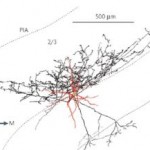Your teacher was wrong!
 I studied neuroscience in college and subsequently taught it for three years at university. One of the central tenants of the course I studied and taught was the dogma of synaptic transmission. The basic tenant of this dogma is that neurons communicate exclusively by sending chemical signals across the synaptic cleft. Pretty much every neuroscience textbook ever written is filled with this idea. It turns out that this is not actually the whole truth. To communicate, brain cells do not need a synapse at all!
I studied neuroscience in college and subsequently taught it for three years at university. One of the central tenants of the course I studied and taught was the dogma of synaptic transmission. The basic tenant of this dogma is that neurons communicate exclusively by sending chemical signals across the synaptic cleft. Pretty much every neuroscience textbook ever written is filled with this idea. It turns out that this is not actually the whole truth. To communicate, brain cells do not need a synapse at all!
This is the surprising news from a team of researchers are the University of Szeged, Hungary. The researchers made the discovery by analyzing a type of neuron called neurogliaforms. Neurogliaform cells (also called dwarf cells or dwarf neurons) are GABAergic neurons – they release the GABA neurotransmitter (the primary inhibitor in the central nervous system).
Neurogliaform cells are widely distributed in the cortex and are involved in many cognitive functions including attention, language, learning, memory, and perception. All of this was known before the team, led by Gábor Tamás, began their study. What was not fully understood was how neurogliaforms communicate.
The group used electron microscopes to analyze brain tissue, which showed that neurogliaform cells have bushy axons with many branches. They examined the terminals at the end of these axons (axonal boutons) and found that of the 50 boutons studied, only 11 formed synapses. In other words, the majority (approximately 78%) of do not form “classical” synapses. My old neuroscience lecturer would have had a fit! If they are not forming synapses, then how are they communicating?
It would appear that the cells are communicating using a mechanism called volume transmission, where the GABA is diffusing in a cloud through the extracellular fluid. The bushy structure of these neurons would seem to be ideal for this type of signaling. Subsequent experiments by the group confirmed that a single neurogliaform can release enough GABA to inhibit nearby neurons, even when no synapses are present.
Another set of experiments showed that neurogliaforms contain receptors that can detect very low levels of GABA. This suggests that they are purpose-built to communicate among themselves, again in the absence of synapses.
This is truly groundbreaking stuff. Just as Francis Crick’s central dogma of molecular biology has gradually yielded to some unexpected molecular acrobatics, so too the dogma of synaptic neurotransmission must be rewritten. Certainly, synapses will remain the main players, but now there is a little competition on the pitch.
| Print article | This entry was posted by connolly on November 12, 2009 at 5:10 pm, and is filed under G2C Online. Follow any responses to this post through RSS 2.0. You can skip to the end and leave a response. Pinging is currently not allowed. |

